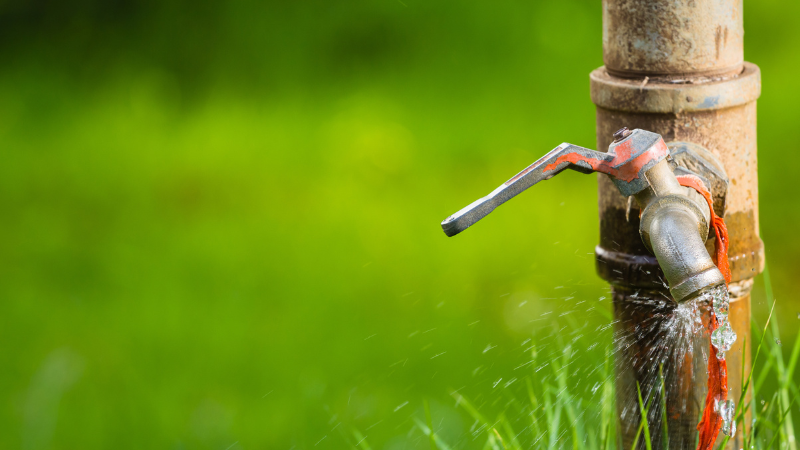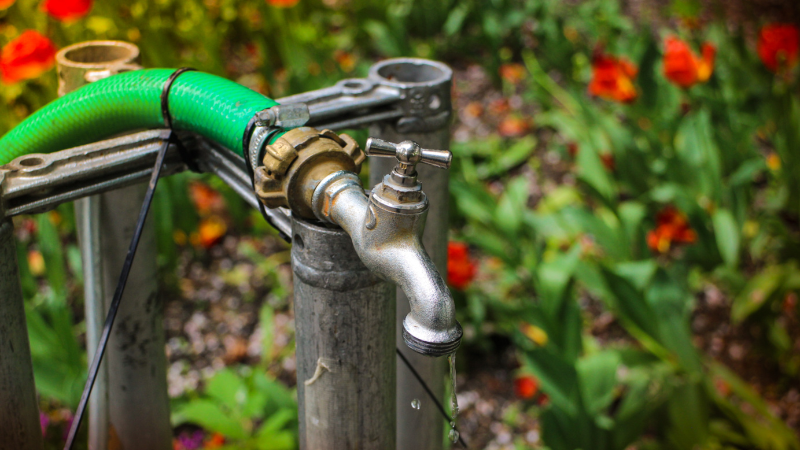Outdoor faucets are one of the most used components on the outside of the home. Whether you use your outside faucet to water your plants, wash your car, or allow your kids to play with the water hose or outdoor toys, it comes in handy quite a bit if your family spends a lot of time outside.
Since this item is used a lot, and it is also exposed to the elements year-round, there is a high chance that it will succumb to normal wear and tear. This is how you can end up with a leaky faucet. Let’s investigate the causes of a leaky outdoor faucet, as well as some repair tips.
Table of Contents
Causes of a Leaky Outdoor Faucet
Let’s first look at how these faucets work so we can understand what can cause them to leak. The most common type of outdoor faucet is a frost-free faucet. It connects to a long pipe that draws water from inside the home which helps it function during cold months. In the installation process of the frost-proof faucet, its fixture is installed in a downward pitch. This allows for the water to drain easily and prevents the tube from getting clogged with frozen water.
There can be many reasons why your outdoor faucet is clogged. Here are a few to be aware of:
Worn out washer:
Washers help with controlling the flow of water. Once they are damaged, the faucet will have a slow drip. In outdoor faucets, worn out washers at the end of the valve stem are the most common type of issue causing a leaky outdoor faucet. Since washers are placed against the valve seat, they have a lot of friction. With time, the friction will wear out the unit itself and is then unable to stop the draining of water out of the faucet.
Loose packing nut:
If you have a leaky faucet, it may also be caused by loose parts inside of the fixture. Usually, packing nuts are at fault for this, as they sit below the faucet handle which is used the most in the unit. If you have a loose packing nut, you will notice a water leak at the end of your faucet.
Damaged pipe due to freezing:
In cold weather, it is common for the pipes to freeze due to low temperatures, which can lead to small cracks in the pipe. Over time, the cracks in the pipes will become larger cracks, which can cause a leak behind the wall as well.
Mineral deposits inside your faucet:
Sometimes calcium, magnesium, and even dissolved oxygen can accumulate over the years inside of your faucet, causing a mineral deposit which can damage the valve seat. If you do not remove it, it can happen around the spout. It takes years for these deposits to form and embed themselves inside of your faucet.
High water pressure:
If you notice that the water pressure is too high, you may have an issue with a leaky faucet. The pressure should be between 40 and 80 PSI, however, if you have a maladjusted pressure regulator, you may get pressure higher than that. If you have this issue, you may see leaking of the faucet during the day or when you move the handle in a certain motion.

Ways to Fix an Outdoor Faucet
There can be various reasons for your outdoor faucet to start leaking. Here are a few ways to fix it based on the most common issues:
Replacing washers:
You can usually replace the washers in your faucets yourself, so you will not need to call a plumber. You will need to remove the head using a pipe wrench to rotate the head counterclockwise. Once it is loose, hold the faucet body and remove the head. Then remove the washer. The washer is a round flat rubber piece that is connected to the outside faucet with a nut. Remove the old washer and replace it by pressing the new one into its proper place. Next, replace the head. You can add some Vaseline to the thread and then fit the head back into its place.
Tightening the packing nut on your faucet:
The packing nut compresses packing material and creates a tight seal that prevents water from being able to drip out. If you are experiencing a loose packing nut, don’t worry, it is an easy issue to fix. In many cases, you can tighten the nut using a wrench and that will fix this issue.
Replacing the pipe on your faucet:
If you are dealing with a damaged pipe, you may need to call a plumber. If you notice your pipe is cracked, you may have an extensive leak, or it may be leaking inside of your basement. This may mean that you will need to replace the long pipe that connects your outdoor faucet to your home. It is always best to call in a professional to do this work to ensure it is done properly.
Cleaning out mineral deposits from your faucet:
If you have mineral buildup in your faucet, the cleanup process is quick. Here is how to do it:
- Remove the faucet aerator by unscrewing it from the spout.
- Soak the fixture in a cleaner. Once you’ve removed the aerator, make sure to soak the pieces in a heavy cleaner or vinegar. To clean the rest of the fixture, you can use the cleaner or vinegar by pouring it in a bag and wrapping it around the fixture, securing it with a rubber band. Let it sit for a few hours and then remove the bag and wipe it all off.
- Finally, rinse the aerator with water and clean it off. Reassemble the faucet and reconnect all the pieces to the fixture.
Adjusting the water pressure regulator:
Locate the water pressure regulator on the main water line which is next to the water meter and the water shutoff valve. It is a bell-shaped device that has a lock nut and an adjustment screw. If you would like to have lower pressure, you can loosen the lock nut and turn the adjustment screw counterclockwise.
Have you experienced an outdoor faucet leak that caused water damage to your home or business? ServiceMaster by Replacements can help. We provide complete water damage restoration services in which we will dry, clean, and restore your property quickly and efficiently. Our highly trained technicians have the proper training, equipment, and methods to restore your property back to its original state.
For all of your water damage restoration needs call us today at (732) 842-6917.







